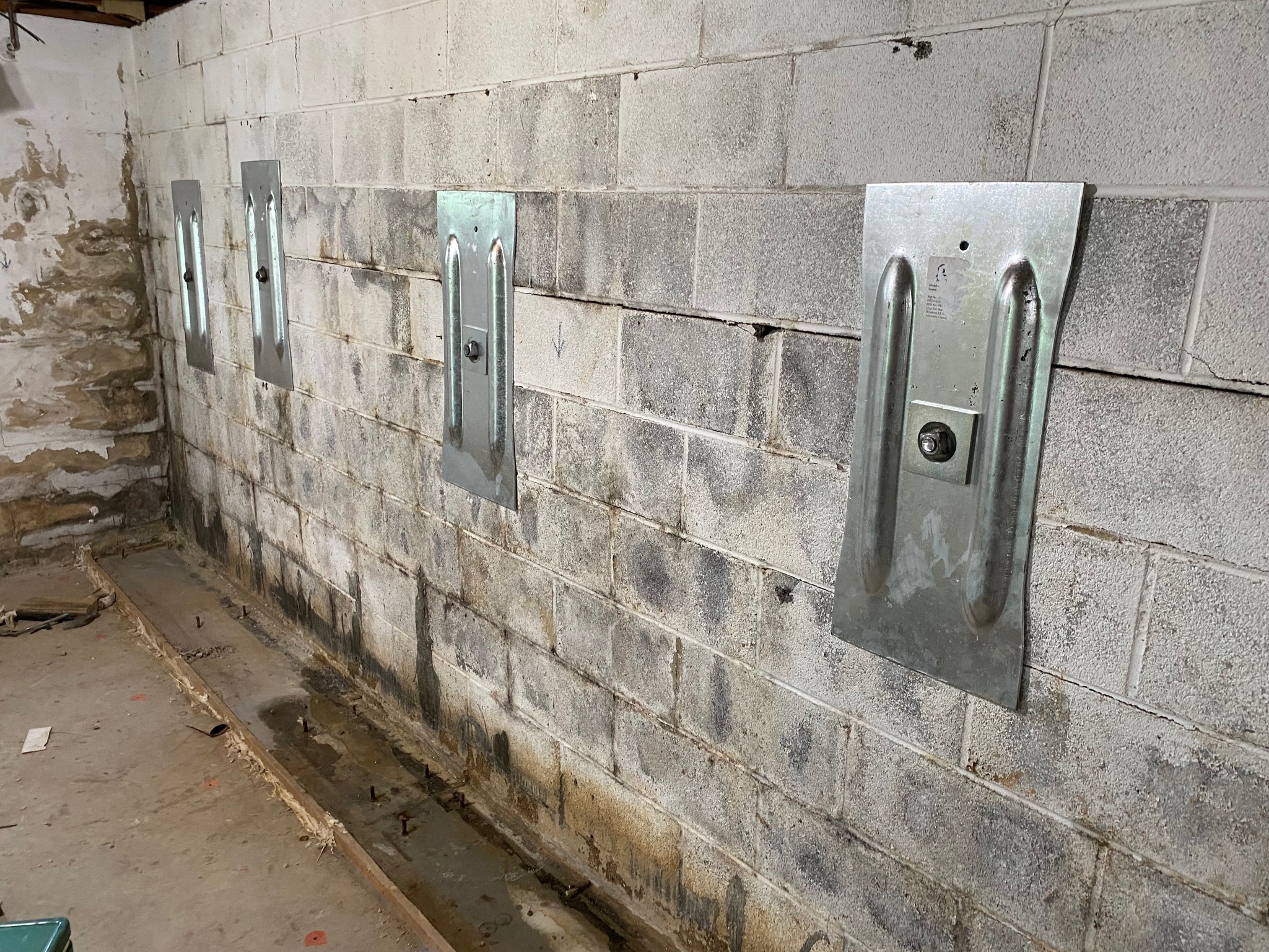
Ever notice those damp spots or cracks appearing on your basement walls and floors, especially after a heavy rain? That musty smell lingering in the air might hint at an unseen enemy: hydrostatic pressure. It’s the force exerted by water in the soil around your home, and it could be the reason behind those relentless basement leaks. But how do you know for sure? Measuring pressure levels might be the key. Yet, there’s more to take into account when spotting this hidden culprit. Curious to learn more? Let’s dive deeper into the world of hydrostatic pressure leaks.
Key Takeaways
- Inspect basement walls and floors for damp spots, which often indicate hydrostatic pressure leaks.
- Look for cracks in basement walls or floors, as these can be entry points for water under hydrostatic pressure.
- Note musty odors, especially following heavy rainfall or snow, as these can signal the presence of a hydrostatic leak.
- Measure pressure levels at different points in the basement; higher pressure at lower levels suggests hydrostatic pressure is the source of the leak.
- Regularly check for water stains on walls or ceilings, as these can be signs of a hydrostatic pressure problem.
Understanding Hydrostatic Pressure
When dealing with basement leaks, it’s vital to understand hydrostatic pressure. This pressure occurs when water accumulates around the foundation of your home, exerting force against the basement walls and floor. Understanding the hydrostatic principles can help you diagnose the issue accurately.
Look at it this way: water naturally seeks the path of least resistance. When the soil around your home becomes oversaturated, the water pressure increases. This is where pressure measurement comes into play. By measuring the level of pressure, you can get a clear idea of how severe the issue might be.
Imagine your basement as a ship’s hull. If the hull breaches, water rushes in, right? The same principle applies to your basement. Hydrostatic pressure can cause cracks in your basement walls and floor, allowing water to seep in.
It’s important to keep an eye on signs of increased hydrostatic pressure around your home. It’s not just about the visible leaks.
Watch for damp spots, mold, or a musty smell. These are often indicators of a more significant issue that you’ll want to address promptly to avoid severe damage to your property.
Causes of Hydrostatic Pressure
You’ve grasped the basics of hydrostatic pressure, now let’s explore what causes it.
Think about the soil composition around your home and how it might influence pressure levels.
Also, consider how heavy rainfall can intensify these pressures, leading to potential leaks in your basement.
Understanding Hydrostatic Pressure
In the world of basement leaks, understanding hydrostatic pressure is essential.
You’re likely familiar with water pressure you experience when diving into a pool—the deeper you go, the greater the pressure. That’s one of the hydrostatic fundamentals. The same principle applies to your basement.
Water in the soil surrounding your basement exerts pressure on your basement walls and floor. This pressure changes based on the amount of water present—the more water, the higher the pressure. That, to sum it up, is how pressure dynamics work.
When everything is dry, the pressure is minimal. But let’s say it rains heavily. The soil soaks up the water like a sponge, and the water pressure against your basement increases.
As the water seeks the path of least resistance, it can find its way into your basement through the smallest cracks or pores in the concrete. That’s hydrostatic pressure in action, and it’s often the main contributor to your basement leaks.
Understanding this concept can help you tackle the problem effectively, making your basement a dry and comfortable part of your home once again.
Soil Composition and Pressure
Digging deeper into the causes of hydrostatic pressure, let’s turn our attention to soil composition. The type of soil surrounding your basement can greatly influence the amount of hydrostatic pressure exerted on your home’s foundation.
Different soil types have varying capacities for water retention and drainage patterns, which directly impacts pressure levels. For instance, clay soils, which are typically dense and less porous, can hold more water, leading to higher hydrostatic pressure.
On the other hand, sandy or gravelly soils allow water to drain more quickly, resulting in lower hydrostatic pressure.
Understanding your soil type can give you valuable insights into how to manage and prevent basement leaks. If you’re dealing with clay soil, you might need to take extra measures to improve the drainage around your home. This could include installing drainage systems or grading your yard away from the foundation.
Conversely, if your soil is sandy or gravelly, you may not face as much hydrostatic pressure, but you’ll still need to monitor for sudden shifts in moisture levels.
In short, soil composition plays a critical role in hydrostatic pressure and basement leaks. So, don’t underestimate the importance of understanding your soil type and its drain patterns.
Rainfall Impact on Pressure
While understanding your soil type offers valuable insights into managing basement leaks, weather elements like rainfall also greatly influence hydrostatic pressure. When it rains, water seeps into the ground, increasing the volume of water in the soil. This increased volume, in turn, raises the hydrostatic pressure against your basement walls. If your basement isn’t prepared to handle this added pressure, leaks are a likely outcome.
Rainwater management becomes essential in preventing these leaks. Efficient rainwater management involves guiding rainwater away from your home’s foundation. You can do this by ensuring your gutters are free of debris and directing downspouts away from your house.
Rainscaping, or creating landscapes that direct water away from your home, is another effective strategy.
Drainage solutions also play a significant role. Implementing a well-designed drainage system can help reduce the potential buildup of hydrostatic pressure. This might be as simple as installing a French drain or as complex as a sump pump system.
Signs of Basement Leaks
Now that you’re aware of the causes of hydrostatic pressure, let’s turn our attention to recognizing basement leaks.
Spotting water damage and identifying mold growth are two significant signs you should be aware of. Understanding these indicators can help you catch a basement leak early, potentially saving you time and costly repairs.
Spotting Water Damage
If you’ve noticed a musty odor or visible signs of mold growth in your basement, you may be dealing with a leak.
But it’s essential to recognize other evidence of water damage too. Water stains, for instance, are a telltale sign that you shouldn’t overlook. These may appear as discolored patches on walls, ceilings, or floors. They often have a yellowish or brownish hue and may be either wet or dry.
In your quest for identifying potential leaks, moisture mapping can become your best ally.
This process involves using a moisture meter to measure and map the moisture levels in your basement. You’ll find that areas with higher levels of moisture are likely the source of your leaks.
Moisture mapping can help you pinpoint these areas and take action swiftly before the problem escalates.
Identifying Mold Growth
On your journey to identifying basement leaks, encountering mold growth is a surefire sign there’s a problem. Mold thrives in damp, dark environments, and a leaky basement provides the perfect conditions.
There are numerous mold types, each with its own distinct appearance. Some molds are black and slimy, while others might appear white and powdery. If you spot any unusual growths on your walls, floors, or even on furniture, you’re likely dealing with mold.
But mold is more than an unsightly nuisance. It also poses significant health risks. Prolonged exposure to mold spores can trigger allergies, cause respiratory problems, and even lead to more serious conditions like asthma.
If you or your family members are experiencing unexplained symptoms such as sneezing, coughing, or headaches, it’s possible that mold is the culprit.
Identifying Hydrostatic Pressure Leaks
While it may seem intimidating at first, identifying hydrostatic pressure leaks is an essential step in basement maintenance.
Leak detection isn’t as challenging as it sounds, and with a bit of know-how, you’ll be able to pinpoint the issue in no time.
Start by visually inspecting your basement walls and floor. Are there any obvious signs of water intrusion like wet spots or dampness?
Next, check for cracks, as these can be a common entry point for water under hydrostatic pressure.
Then, it’s time for pressure measurement. This might sound technical, but it’s simple. Hydrostatic pressure increases with depth, so you’re looking for higher pressure at the bottom of the walls or floor.
You can use a pressure gauge to measure this, and if the pressure is considerably higher at the bottom, you’ve probably found your leak.
Finally, smell can be a big giveaway. Hydrostatic pressure leaks often bring a musty, damp odor with them.
If you’ve noticed this smell in your basement, it’s likely you have a leak.
Difference Between Regular and Hydrostatic Leaks
You’ve now learned how to identify hydrostatic pressure leaks in your basement. But how do these differ from regular leaks? It’s important to understand the distinctions to properly diagnose and address the issue.
Regular leaks typically occur due to pipes’ wear and tear or plumbing issues. These leaks are prominent near pipes, faucets, and fixtures. You’ll often spot dampness, water stains, and even mold growth around these areas.
On the other hand, hydrostatic leaks, originating from water pressure buildup in the soil surrounding your basement, are a different beast. They’re usually seen after heavy rain or snow when the water has nowhere else to go but pressure its way into your basement.
You’ll notice these leaks at the lowest points of your basement, often seeping up through cracks in the floor, even causing flooding.
Both types can cause significant damage, but their sources are different. Regular leaks are often internal and easier to fix. Hydrostatic leaks are external, requiring more thorough solutions.
Solutions for Hydrostatic Pressure Problems
Facing hydrostatic pressure problems in your basement can be intimidating, but don’t despair.
You’ve got solutions, and we’re here to help you understand them. It’s important to address hydrostatic pressure issues promptly to prevent further damage.
So, what can you do about it? Here are 4 effective strategies:
- Interior Water Drainage: This is one of the most effective drainage solutions for hydrostatic pressure. Interior water drainage involves installing a system inside your basement to redirect water from the floor and walls to a sump pump.
- Sump Pumps: Sump pumps are devices installed in a pit in your basement. They pump out any water that collects there, keeping your basement dry.
- Exterior Drainage: This involves installing drains or channels around the exterior of your home to divert water away. It’s more invasive and costly but can be very effective.
- Crack Repair: Sealing cracks in your basement walls can help manage hydrostatic pressure, but it’s more of a temporary solution.
Preventing Future Hydrostatic Pressure Leaks
Now that you’re familiar with the solutions for hydrostatic pressure problems, let’s focus on preventing these issues in the future.
Prevention is always better than cure, right? So, where do you start?
Firstly, pay attention to your drainage systems. They’re key players in managing hydrostatic pressure. If they’re not working properly, water accumulates around your basement, increasing pressure against the walls and floor.
Make sure your gutters and downspouts are clear and directing water away from your home’s foundation.
Next, consider installing a waterproof membrane. This barrier goes on your basement’s exterior walls and acts as a second line of defense. It prevents water from seeping into your basement, even if pressure builds up.
It’s not a quick DIY job, though. You’ll likely need a professional to install it properly.
Frequently Asked Questions
What Are the Effects of Hydrostatic Pressure on Home Foundations?
Hydrostatic pressure can seriously threaten your home’s foundation integrity.
It’s the force that groundwater exerts on your home’s foundation, leading to potential leaks and cracks.
If you’re noticing water in your basement or cracks in your foundation, it’s a sign you’re dealing with hydrostatic pressure.
Proper pressure management is essential to prevent extensive damage.
Regular inspections and drainage solutions can help maintain your home’s foundation safety.
Can Hydrostatic Pressure Cause Damage to Other Parts of the House?
Absolutely, hydrostatic pressure can damage other parts of your house.
It’s not just about basement leaks. Over time, this pressure can compromise your foundation’s stability. It can cause cracks in walls, uneven floors, and even structural damage.
Furthermore, poor water drainage exacerbates the issue, causing more pressure build-up.
Does Homeowners Insurance Typically Cover Damage Caused by Hydrostatic Pressure?
You’ll find that homeowners insurance typically doesn’t cover damage caused by hydrostatic pressure.
It’s generally considered a maintenance issue, not an unexpected event. Most policies have exclusions for “water damage”, which often includes this type of pressure.
However, it’s always best to check your specific policy or consult with your insurance agent to understand exactly what’s covered.
Can Hydrostatic Pressure Lead to Mold or Mildew Growth in the Basement?
Yes, hydrostatic pressure can indeed lead to mold or mildew growth in your basement.
When there’s high hydrostatic pressure, it pushes moisture through your basement walls and floor. This consistent moisture provides the perfect environment for mold and mildew to thrive.
It’s crucial to maintain moisture control and implement mold prevention strategies, such as using dehumidifiers and ensuring proper ventilation, to keep your basement dry and mold-free.
Are There Any Warning Signs of Rising Hydrostatic Pressure Before a Leak Occurs?
You’ll notice several warning signs of rising hydrostatic pressure before a leak occurs.
Look for cracks in your basement walls or floor. You might also see efflorescence, a white, powdery residue left by evaporating water.
Damp spots or mold can be pressure indicators too. These are all signs that water’s pushing against your basement, and a leak may be imminent.
Don’t ignore them, take immediate action to prevent damage.
Conclusion
So, you’ve learned how to spot hydrostatic pressure leaks in your basement. Remember, look for damp spots, cracks, and musty odors. Early detection is key to avoiding major water damage. Understanding the difference between regular and hydrostatic leaks can also help you fight the problem. Don’t forget, there are solutions available to address this issue. With proper steps, you can prevent future hydrostatic pressure leaks and keep your basement dry.

Seal-tite Basement Waterproofing Co. is a full service basement environment contractor. We carry an A+ Better Business Bureau rating. We repaired over 40,000 homes and structures in Virginia, West Virginia, Tennessee, and North Carolina. We are fully insured and licensed. We have worked in all types of locations, including residential and commercial locations, government agencies, colleges, hospitals, churches, and condo associations.
Seal-tite® offers a lifetime transferable warranty. We carry a Class A Contractor’s License and we are fully insured. Our satisfied customers range from government agencies to businesses, hospitals, colleges, churches, and thousands of homeowners. Your home is probably the single largest investment you will make in your lifetime. Don’t wait, call Seal-tite® to help make your home dry, safe and livable.

